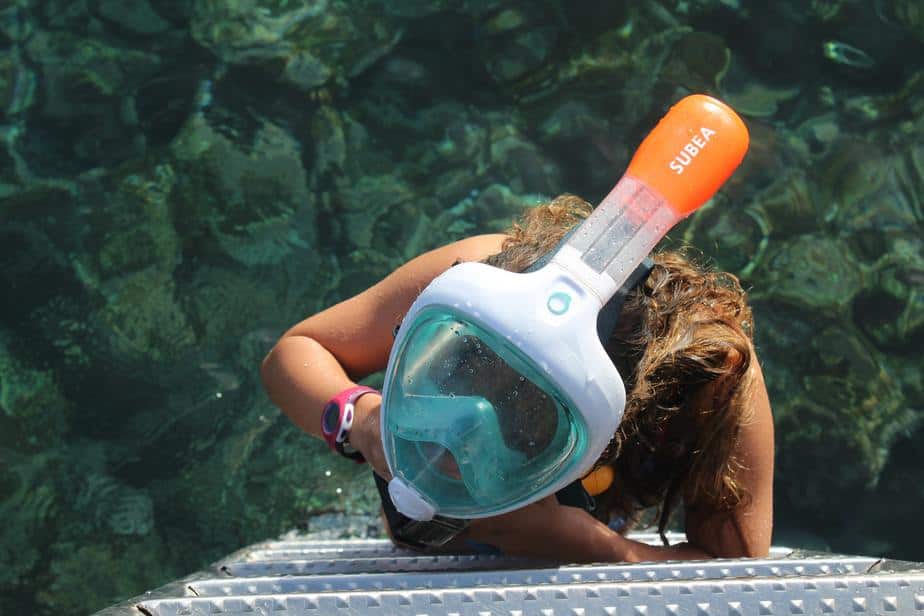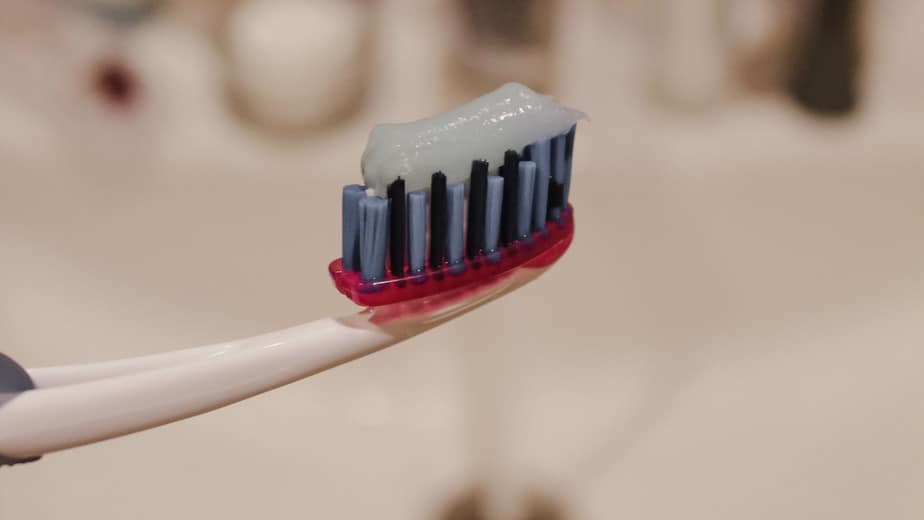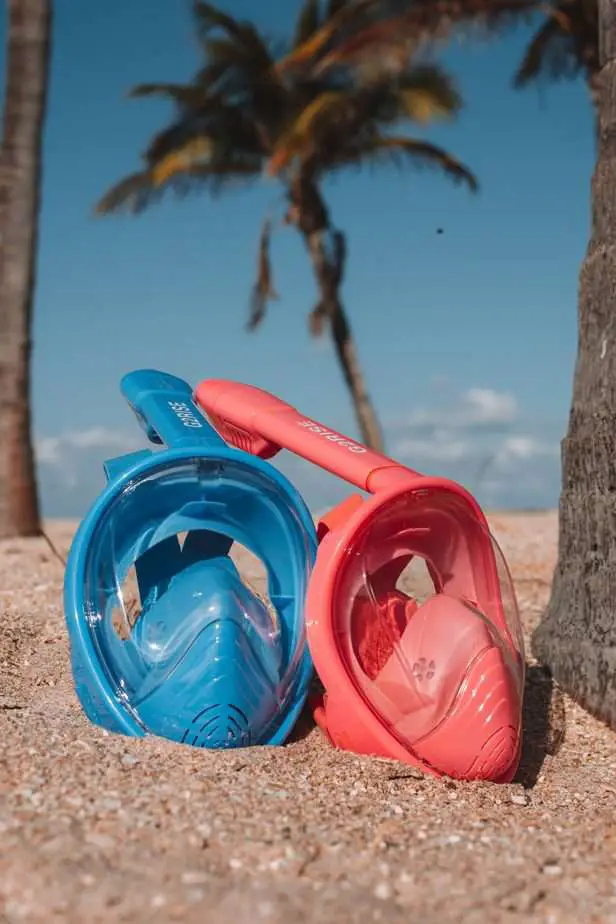When your mask fogs up, it’s one of the most annoying and frustrating problems that can ruin your snorkeling experience. It’s especially frustrating when you finally find a mask that fits your face and you think you can finally snorkel without interruption, only for this issue to arise.
This is a major problem in a traditional snorkel mask, because when you exhale through your nose to equalize the pressure in the mask, warm air is introduced into the mask which will speed up the fogging process.
Thanks to the innovative design of full face masks, wearers can not only breathe entirely with their nose (mouth breathing is optional), but by compartmentalizing the mask and separating the mouth and nose section from the eyes, much of that warm air will be kept away from the lens, keeping it from fogging up. Yet, a full face mask can still fog up anyways. Why is that?
There are ways to clear the mask quickly, and perhaps you’ve even gotten very efficient at mask clearing from a horizontal position. However, why not stop the problem at its source and keep the mask from fogging up in the first place? In this article, we will go over some tips you can follow to ensure that your full face snorkel mask stays relatively fog-free so that you can enjoy your snorkeling experience with minimal interruptions.
Why do full face snorkel masks fog up in the first place?

When your snorkel mask or swimming goggles fog up, what’s happening is water vapor is condensing on your mask lens because of the temperature difference between the inside and outside of the lens surface. The moisture that accumulates inside your mask has to attach to something, and one such thing is your mask lens.
Unfortunately, there is no way to keep your mask from fogging up. As long as the mask remains on your face, your natural body heat is going to cause the inside of the mask to be warmer than the outside.
In a traditional dive mask, exhaling through the nose was only done as needed to equalize; unless you were also duck-diving while snorkeling, equalization was rarely needed.
If you were content to just stay by the surface, there would be no pressure to equalize and therefore you do not even need to exhale through the nose at all.
That said, our body is constantly generating heat whether we exhale through the nose or not, so all we can do is delay the time it takes before the mask fogs up so much that it needs to be cleared.
There are some factors that can speed up how quickly your mask fogs over, which we want to avoid. For instance, there is often a residue left over from the manufacturing process that coats the lens, and fog can form on and between that residue and the lens itself.
Additionally, dirt and oils can accumulate on the lens from regular use, as well as microscopic imperfections on the lens can cause the mask lens to fog over quicker. To delay how quickly fog can coat your lens, you should be diligently cleaning your mask and applying defogging solution on the lens.
Top methods to prevent your full face snorkel mask from fogging
Pre-treat your mask
So, about that residue on your mask lens that is applied during the manufacturing process – it’s most likely still there if you have a brand new mask that’s never been treated before.
Many first-time buyers of full face masks are dismayed when they realize their fancy new mask still fogs up like their old dive mask. Well, that’s probably because they didn’t deal with the residue.
First, you need to figure out whether your mask lens is made of plastic or tempered glass. If it’s made out of plastic, there’s not much you can do about removing the residue due to the nature of the solution.
What many people do to get rid of the residue is they literally burn it off. That’s right, get an open flame like a candle or a lighter and put that flame close to the lens (the flame does not have to touch the lens).
Make sure it’s some distance away from any plastic sections, i.e. the mask frame, otherwise you may melt or warp the plastic. You can just keep the flame mostly at the center of the lens and get a teeny bit closer to the edges without melting the frame.
Naturally, there is a risk to this. You could burn yourself, or you could ruin your mask. Therefore, the choice is up to you whether you are okay with the burning method or not.

After you’ve gotten rid of the residue, get a toothbrush with soft bristles and toothpaste. Scrub the mask lens, particularly the inside part, with the soft-bristled brush and make sure the toothpaste is being applied evenly. We are cleaning off the oils and any other debris that still might be lingering on the lens.
A common mistake people make is they use their fingers to apply and spread the toothpaste (even the video I linked recommends it, but it’s not optimal). Do not use your fingers. This is counterproductive because the natural oils on your fingertips will transfer to the lens, therefore you are not cleaning the lens at all. Use a toothbrush or at least a soft cloth, NOT your fingers.
If you decide not to pre-treat your mask because you think your brand new mask is usable right off the bat, then your mask will certainly fog up faster if this crucial step is not taken.
Coat the lens with a defogging solution
After you have finished treating and cleaning your mask, if you do not intend on wearing it right away, make sure you fully dry the mask. Use a towel and make sure not to accidentally smudge the lens with your fingers. Leave it out to fully air dry before storing it. Depending on how long it’s stored for, you may need to clean it again before wearing it into the water.
Commercial defogging solution
- Effective anti-fog gel for masks and goggles. It is an ideal accessory before snorkeling and scuba diving
- Given its neutral pH (7.0) and the zero irritability of its components, it is ideal for use on surfaces near the eyes
- Its base is only deionized water and does not contain any type of organic solvent since under immersion conditions, they could evaporate and affect...
Before you head out into the water, you can do one final step to make the lens even more fog-proof, and that’s applying a commercial defogging solution to the inside of the lens.
You might be wondering what the best brands are, but in truth, it doesn’t really matter. I’m sure whatever your local dive shop has stocked on its shelves is good, as is whatever you can get online on sites like Amazon.
Baby shampoo
Another viable defogging solution is using a mild baby shampoo solution; all you need to do is apply a few drops and quickly rinse it out. You may already have some at home. If you don’t, they are very cheap and one bottle lasts a long time.
Many scuba divers keep this product around because it’s an easy way to clean their gear after a diving session, and it works well for cleaning snorkeling gear as well.
Since this product will be in close proximity with your eyes, make sure you are using baby shampoo, not regular shampoo, otherwise you will irritate your eyes. Baby shampoo is very gentle on the body, plus they are hypoallergenic and biodegradable which can help preserve the environment.
Spit
Another option – and we are totally serious about this – is to use spit as a natural defogger. This is an ever cheaper option but sometimes you get what you pay for. It’s not the most effective solution nor is it the most sanitary, but it works surprisingly well considering anyone can do it for free. It’s better than nothing if you forgot to bring your mask defogger with you.
If your mask starts to fog up while you’re in the middle of snorkeling and you don’t want to return to shore to apply more mask defogging solution, a quick and dirty solution is to tread water for a bit and coat the inside of your lens with spit. Then rinse the spit off with water and get as much water out of the mask before you put it back on.
Potato
Potatoes are a versatile food; so versatile in fact, that it can even be used as a mask defogger! And the good thing is, chances are you already have potatoes at home, so you can just grab one from the kitchen.
All you need to do is cut a small section of the potato, squeeze some juice out of it, and then rub the inside of the mask lens with the slice of potato. Finally, rinse off the potato juice and your mask should be clear and fog-resistant.
Whichever option you decide to go with (commercial defogging product, baby shampoo, spit, potato), we need to remind you that you must be very careful during the application process. Do NOT use your fingers!
You’ll want to apply the defogging solution on the inside of the lens before you enter the water, and then give it a little rinse with water. Get as much water out as you can before putting the mask on your face.
Wear the mask with a dry face
For best results, we highly recommend you dry your face with a towel and even dry the mask skirt before putting on the mask. This will ensure that the mask has the tightest seal on your face.
Now, this doesn’t necessarily do much to prevent the mask from fogging up, but if water is leaking in, then all of your prep work will be for naught. You also don’t want to take the mask off your face if you don’t need to, so secure it as tightly as possible.
Thoroughly clean your mask after each use
After each snorkeling session, make sure you thoroughly rinse your snorkeling gear, the mask and snorkel especially. Fill a bucket with lukewarm or cool, fresh water. Put your snorkeling equipment in the bucket and rinse it thoroughly. Once rinsed, dry it with a towel before storing it in your bag.
Once in a while, you should do a more thorough cleaning using a mild soap (hand soap or dish soap will suffice) to ensure any dirt or oil does not accumulate on the lens. Or you can just use soapy water every time if you’re a stickler for cleanliness.
Just as important as cleaning your mask, you must make sure the mask has been fully dried before storing it. Use a towel to wipe the mask dry, making sure not to get any smudges on the lens. Then, leave it in a ventilated area away from direct sunlight to air dry.
There may still be a few droplets of water you missed while drying with a towel, and this step ensures that the mask is truly fully dry before you store it.
Failure to properly clean or dry your mask can cause irritation, fogging, or mold to grow on the mask. Properly cleaning, drying, and storing your mask will prolong its lifespan.
Parting words
It can be frustrating dealing with a foggy snorkel mask, and unfortunately full face masks not only suffer from the same problem.
We imagine many people encounter this problem – they buy this fancy new mask design to replace their traditional snorkel mask only to encounter the same problem.
So before you decide to get too carried away with your new purchase, you need to first be aware of how to pre-treat your mask, maintain it, and to apply your preferred defogging solution to keep the mask from fogging up.
As mentioned, we can only delay the mask from fogging up, but we cannot fully prevent it from happening. As long as the mask is on your face, your body will generate heat over time, warming up the air inside the mask and causing condensation to form on the lens.
There’s not really a “fix” other than to follow the tips in this article, try to conserve as much energy as possible while snorkeling, and just pray that you can last an entire session without dealing with fog. Good luck and have fun snorkeling!
Last update on 2024-07-14 / Affiliate links / Images from Amazon Product Advertising API



